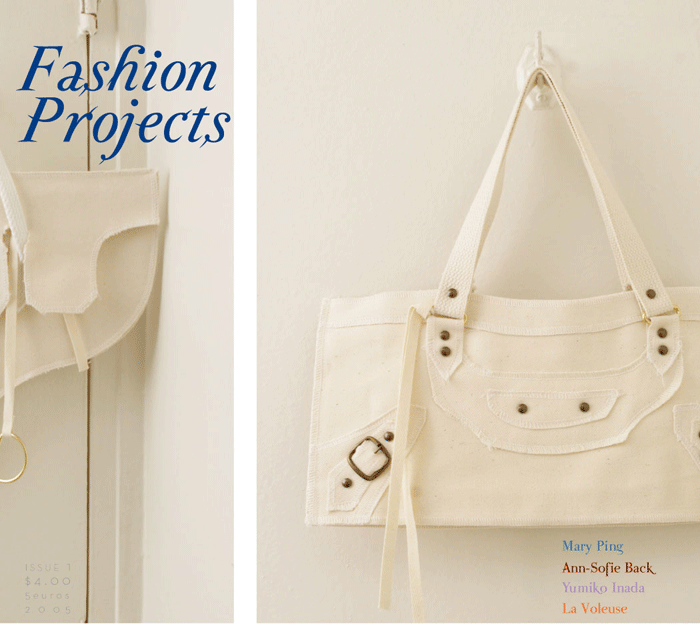Spring/Summer 2004. Photo by Anders Edstrom
The Victor & Rolf exhibition at the Musée de la mode in Paris, and other museum exhibitions like, "Skin Tight" at the Chicago Museum of Contemporary Art, and "Fashination" at the Museum of Modern Art in Stockholm draw attention to how fashion as an art form is exerting greater influence on the world's leading artists, and in the same way many fashion designers are blatantly incorporating references to contemporary art in their creations. Do you feel that the border between fashion and art is disappearing?
No, I think the divide between fashion and art has never been wider. Look at what is actually in the shops. It's so boring you want to cry. This is the reality. Just because there are lots of people sitting in their bedrooms making weird clothes that get photographed in some obscure magazine doesn't mean anything has actually changed. The difference is artists and galleries have all of a sudden realized fashion has a lot more depth to it than they previously imagined, from Prada to Cosmic Wonder. Fashion has a better status in the art world-that's all. But fashion is business first, art or craft second. Tom Ford is right, I'm wrong. Maybe surprisingly, I find clothes that you can't wear boring as well.
Do you think that the marriage of art and fashion is a beneficial relationship?
I'm ambivalent about this. Part of me thinks, "We don't need you to make us feel better, you don't have a clue what a difficult job we are doing, you lazy sods." The other part of me thinks, "Yeah, this i s fun!" Right at this minute the answer is No, but this opinion doesn't stop me from exhibiting in art galleries.
What do you think of artists borrowing from fashion imagery (for example, Vanessa Beecroft's work)?
With her, it's great but it really depends on the art. I hated what she did at first, but now I've grown to really like it. To be honest, I'm bored with art. I don't understand half of it and mostly it pisses me off. It pisses me off because perhaps I feel I'm not intelligent enough to understand it. I don't have the patience to form an opinion about art these days. I'm trying to avoid it. I also think fashion is so much more interesting than art.
You are often quoted as being intrigued with the concept of "striving for a perfection that is impossible to attain in real life," and "uninterested in glamour." Yet in your previous collections, it is precisely this glamour and elegance in the feminine silhouette that is often conveyed in your garments. Do you feel that a set idea of fashion has been deeply engrained socially and culturally, in our mindset as something eternally frivolous and dissolving?
I'm interested in the aspirations that we have for glamour, not the glamour itself. I think people's attitude towards fashion and clothes are changing. I think most people, if they are honest, understand the importance of clothes, style, and appearance these days--be it artists, Muslims or my dad. Television and The Sun make fashion seem trivial, not real people.
Your Spring/Summer 2004 collection featured customized Shelley's stock shoes made with artificial tresses, entwined as straps, which recall the Surrealist's incongruous juxtaposition of objects (Oppenheim's fur covered tea cup and Schiaparelli's lobster dress initially come to mind). What were the motivation and inspiration behind creating these shoes?
It came from the clichéd signs that transvestites use to become women: a blonde wig, fishnet stockings, a trench coat, etc. It's like a "woman-mask" that is more woman than a real woman. Hence the blond wig shoes. I tend to design intuitively and try to make sense of it afterwards.
Also your "all in one outfit," with all the accessories: the scarf, belt, and dress encapsulated within a transparent outer layer, seems to be a sardonic commentary on the banality of dressing and the very idea of seeing and being seen in fashion.
Yes, and of the difficulty of dressing, namely the possible disasters that I can certainly achieve in the morning.
You're not afraid to use and mix different fabrics and materials such as fake lamé, leather and velvet. How much of your work is a result of experimentation and how much of it is of premeditation?
With fabrics, I tend to use the ones I identify with or feel sorry for. They are either almost invisible (because they are so boring and common that you don't see them) or they are really loud. I use the type of fabrics that you sew a top in, wear once and then realize you look like a hooker and throw it away. The problem is, most buyers don't really appreciate this and find my fabric choices difficult. So I'm trying to be a bit more sensible now. I would say half of the collections are premeditated, the rest is experimenting.
What about the "blouse bag" and the "sweater bag" from your Autumn/Winter 2004 collection. Are you into using traditional elements to create new, but somehow familiar pieces?
Yes, I think my ideas work best based on existing, easily recognizable pieces. What I call "normal" clothes.
 Published January 2006
Published January 2006









